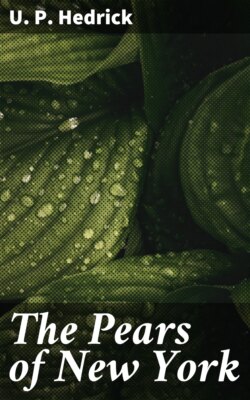Читать книгу The Pears of New York - U. P. Hedrick - Страница 39
На сайте Литреса книга снята с продажи.
BELLE LUCRATIVE
ОглавлениеTable of Contents
1. Lindley Guide Orch. Gard. 364. 1831. 2. Kenrick Am. Orch. 135. 1841. 3. Hovey Fr. Am. 1:41, Pl. 1851. 4. Am. Pom. Soc. Rpt. 53. 1852. 5. Field Pear Cult. 194, fig. 68. 1858.
Fondante d’Automne. 6. Downing Fr. Trees Am. 387, fig. 168. 1845. 7. Hogg Fruit Man. 578. 1884.
Seigneur. 8. Ann. Pom. Belge 7:5, Pl. 1859. 9. Pom. France 1: No. 28, Pl. 28. 1863. 10. Mas Le Verger 3: Pt. 1, 21, fig. 9. 1866–73.
Bergamote Lucrative. 11. Leroy Dict. Pom. 1:247, figs. 1867.
Seigneur d’Espéren. 12. Guide Prat. 59, 303. 1876.
Esperen’s Herrenbirne. 13. Mathieu Nom. Pom. 212. 1889. 14. Gaucher Pom. Prak. Obst. No. 37, Pl. 85. 1894.
Lucrative. 15. Am. Pom. Soc. Cat. 36. 1889.
This good old pear has been a standard autumn sort for nearly a century. The internal characters of both flesh and flavor are nearly perfect, but externally much more might be desired as to shape and size. In flesh and flavor, the fruits are of the Bergamot type—fine-grained, buttery, juicy, and sugary, with a musky taste and perfume. The fruits are not as large as is desirable, and are variable in shape and color, external defects which a rather handsome color offsets in part. The trees are more satisfactory than the fruits. They bear enormously and almost annually on either standard or dwarfing stocks; they are very vigorous, with a somewhat distinct upright-spreading habit of growth; are hardier than the average variety of this fruit; and are rather more resistant to blight than the average variety. The fruits are too small for a good commercial product, but their delectable flavor and luscious flesh make them as desirable as any other pear for home use; besides which the trees grow so well, and are so easily managed that the variety becomes one of the very best for the home planter.
Belle Lucrative is of Flemish origin. In 1831 it was growing in the London Horticultural Society’s gardens at Chiswick, and was then described by Lindley as “another of the new Flemish pears.” It had been taken to England by a Mr. Braddick who received the cions from M. Stoffels of Mechlin. By some writers it is considered probable that it originated with M. Stoffels, but the leading Belgian and French writers say that it was raised by Major Espéren, also of Mechlin, about 1827. In this country it first fruited in the Pomological Garden of Robert Manning, Salem, Massachusetts, in 1835 or 1836. The American Pomological Society added the variety to its fruit catalog-list in 1852 under the name Belle Lucrative.
Tree medium in size, vigorous, upright-spreading, dense-topped, rapid-growing, hardy, productive; branches smooth, grayish-brown mingled with red, covered with scarf-skin, with numerous elongated lenticels; branchlets slender, short, light brown, glossy, smooth, glabrous, with few small, inconspicuous lenticels.
Leaf-buds small, short, conical, pointed, plump, appressed. Leaves 3 in. long, 1½ in. wide, stiff; apex abruptly pointed; margin finely serrate, tipped with very small, sharp glands; petiole 2 in. long. Flower-buds conical, pointed, plump, free, singly on very short spurs; flowers with an unpleasant odor, showy, 1½ in. across, average 7 buds in a cluster; pedicels 11⁄16 in. long, thick, thinly pubescent.
Fruit ripe in late September and October; medium in size, 2⅜ in. long, 2¼ in. wide, obovate, conical, with sides unequal; stem 1⅛ in. long; cavity very shallow and narrow, or lacking, the flesh drawn up about the base of the stem; calyx open, large; lobes long, narrow, acuminate; basin shallow, obtuse, smooth; skin thin, tender, smooth; color dull greenish-yellow, thickly sprinkled with small, russet dots, often overspread with russet around the basin; dots numerous, small, russet, conspicuous; flesh tinged with yellow, firm, fine-grained, crisp, buttery, juicy, sweet; quality very good. Core closed, abaxile; calyx-tube long, narrow, funnel-shaped; seeds narrow, plump, acute.
